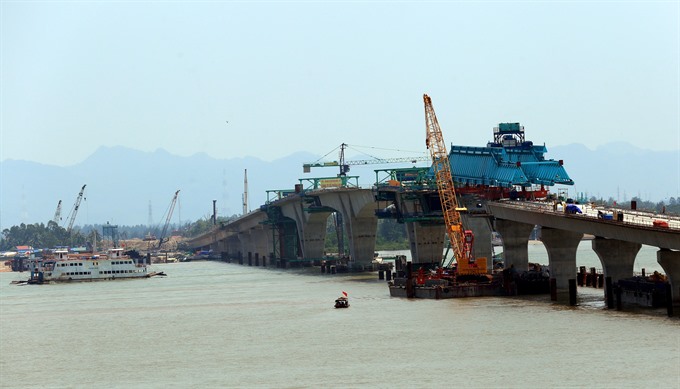 Politics & Law
Politics & Law

The second session of the National Assembly yesterday continued with debates on a five year financial plan, targets and orientation for the mobilisation and use of public investment loans as well as public debt management during 2016-2020.
 |
| The Tân Vũ - Lạch Huyện Highway project currently being implemented by contractor consortium Sumitomo Mitsui – Cienco4 of Trường Sơn Corporation JV in Hải Phòng City. - VNA/VNS Photo Huy Hùng |
HÀ NỘI – The second session of the National Assembly yesterday continued with debates on a five year financial plan, targets and orientation for the mobilisation and use of loans as well as public debt management during 2016-2020.
Finance Minister Đinh Tiến Dũng presented a report on national public debt by providing data that shows the reality of public debts over the past five years.
Dũng said public debt reached VNĐ2.6 quadrillion (US$117 billion) last year, or an increase of 2.3 fold over 2010 and 14.8 fold over 2001. He said the annual growth pace of public debt in the 2011-15 was 18.4 per cent, or three fold over annual GDP growth rate, which was about 5.9 per cent.
Many deputies agreed with the report’s assessment on the current situation of public debt saying that the mobilisation and use of loans and public debt management in 2011-2015 had been presented extensively.
The report revealed the soaring public debt had resulted in high repayment pressure and regulations on public investment were not strict enough to prevent violations, which led to the ineffective use of loans.
Trần Hoàng Ngân, a deputy from HCM City warned public debts were on the rise and they would likely exceed the national red line of 65 per cent of GDP.
Ngân mentioned the law on public investment issued last year, saying that Article 75 assigned a role for the NA to adjust the Government’s public investment plans.
Therefore, the deputy said, the Government should annually report on the process of implementing public investment plans to the NA so that the NA could advise on adjustments for them.
The adjustments might include changes for key investment sectors or changes of the project implementation duration.
In Việt Nam, public debt includes Government debt, debts underwritten by the Government, and debts incurred by provincial and municipal authorities.
Government debt alone, which is domestically and internationally incurred by the Government and the finance ministry, exceeded a cap of 50 per cent of GDP.
Public investment plan
At the meeting, deputies also heard Minister of Planning and Investment Nguyễn Chí Dũng reporting on the medium-term public investment plan for 2016-2020 and the report on public investment in 2011-15
Deputy Nguyễn Ngọc Phương, from the central province of Quảng Bình, said the Ministry of Finance’s report had shown the truth but did not provide details or the accurate number of ineffective projects, or those that were suffering from capital losses as well as reasons behind and solutions for them.
Phương requested more specific figures for ineffective projects and a list of individuals or organisations that were responsible for the losses.
The deputy said there should also be strict punishments for such violations, so as to deter others.
Phương cited five projects suffering huge losses of investments as examples, including the VNĐ12 trillion (US$533.33 million) Ninh Bình fertiliser plant of the Việt Nam National Chemical Group in nothern Ninh Bình Province, which was struggling with annual losses of VNĐ2 trillion, and the operations at the VNĐ7 trillion Đình Vũ polyester factory, in which the Việt Nam Oil and Gas Group held a controlling stake, halted for more than a year after it went on stream in 2014.
He said such projects had caused huge economic losses worth over VNĐ30 trillion ($1.3 billion), but did not specify the names of individuals who should be held responsible for the losses.
The need to clarify responsibility for the losses was the key factor in helping improve awareness of the management of public investment, according to Phương.
Meanwhile, Nguyễn Thị Bé, a deputy from the Mekong Delta province of Kiên Giang, lauded the Government’s middle-term plan of public investment for 2016-2020, as transparent and open, to avoid misspending while prioritising urgent projects and works.
Yet, others commented that the allocation of capital stated in the plan has yet to match with the investment distribution criteria mentioned in the report, as many urgent projects have yet to be included in the plan.
They pointed to the Mekong Delta region as an example. Two thirds of the region is forecast to be flooded and needs adequate investment to ensure production and national food security, but it will only receive investment for the building of several dykes to prevent seawater intrusion in the next five years.
They also proposed that the Government and the NA prioritise the building of infrastructure and irrigation systems for the region – which is dubbed as the rice bowl of the country.
The majority of deputies asserted that the plan should focus on agriculture and rural development, environmental protection, especially the cleaning up of the sea environment in four central provinces affected by the Formosa-caused environmental incident, as well as climate change and saltwater intrusion response, and transport systems in Northwestern and Central Highlands regions, and coastal roads connecting southwestern localities.
They also suggested resources be focused on the construction of the North-South Expressway and railway.
They also asked for further clarification of projects receiving investment and strict punishment on violations in public investment to enhance investment efficiency. — VNS




